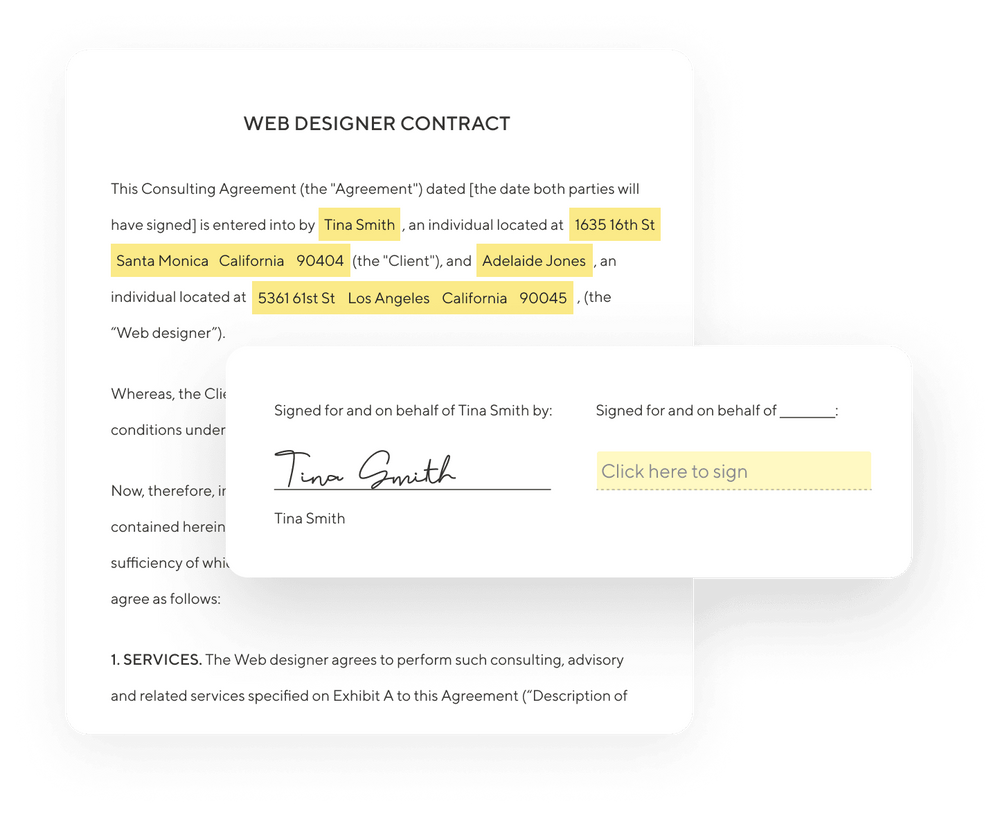A graphic designer retainer contract is a recurring contract that is not based on the number of hours worked, but on the availability of the freelancer over a period of time.
Retainer contracts for graphic designers have multiple advantages for both clients and freelancers because they provide consistency on both ends.
As a freelancer, you have the opportunity to have a stable income and client work so you can plan ahead and better understand your bandwidth for bringing in new clients.
Retainers: How do they work?
A retainer is an established agreement between you and the client stating that you will, essentially, dedicate a specific number of hours in the week to working for them. For example, you could work 20 hours each week with a client for a monthly retainer rate. During these 20 hours, you're basically on call at any moment. Your client may have enough work for you to fill up those hours, or they may not.
However, the good news is, in a retainer agreement you'll still get paid even if a client doesn't have work for you. Some weeks may be busier than others. And if a client needs you for the full 20 hours, you'll need to make sure you can provide that time as part of the contract. If you're working with multiple retainer clients, you'll need to make sure your schedule won't conflict with other client projects.
Benefits of working on retainers
For a professional designer, landing retainer work is the dream. A design retainer lets you work with a business for an established period of time with the opportunity to extend the contract. Here are some of the biggest benefits of working on retainer.
Stable income
Freelancing can be very unpredictable when it comes to income. Design retainers give you a much more predictable income and a steady flow of work. If you have a few retainer clients built up, you can quickly add together the monthly retainer rate for each client and immediately know how much you can expect to make each month.
Fewer clients
A major part of being a freelance graphic designer is having to find new clients to maintain a steady income. This process can take a lot of time and involves having to learn about new clients constantly. This is another big reason why many graphic designers seek out retainer work. You get to work with a handful of clients on an ongoing basis. A few long-term clients are much easier to manage than many short-term clients. It reduces stress, you'll have a better understanding of your client's needs, and you get to feel more like you're part of a team.
Easier to charge clients
Another challenging part of being a freelancer is knowing what to charge for client projects. Depending on the size of the business, scope of the project, and other factors, you'll likely have fluctuating design fees. On the other hand, a retainer fee is a flat rate, making it much easier to nail down your rates.
Types of graphic design retainer contracts
There are several different types of retainer contracts, and these should be negotiated with your client depending on what you offer and the services that are needed. We've included a few examples below that are a great starting point.
Traditional retainer: A traditional retainer is a set payment to work either a fixed amount of hours or complete a certain amount of projects. This can be 10 hours a month for graphic design support or 3 completed landing pages per month for an agreed-upon rate.
Rolling hours: Some retainer contracts are based on a certain amount of hours that are counted over the month. If there are any unused hours, they roll over to the next month. This is less common than other retainers and we would not recommend going this route if you're able to avoid it.
Access to an expert: Other retainer contracts are focused on value and not the specific amount of hours worked. This is mostly to have an expert on call to be available to answer questions or help support the team when it's needed.
Once you have agreed to a specific type of retainer contract, there is certain information that should be included within the contract.
What to include in a retainer agreement
A retainer agreement is structured a bit differently from a traditional freelancing contract. That's because you'll need to establish the terms for elements that are specific to a retainer package. We'll cover these elements now:
Money, honey
Make sure you outline the amount of money that will be paid and how often you will be paid. Include any additional information on who is responsible for expenses related to the project and any other possible reimbursements.
Services & statement of work
Here's where you outline what exactly you'll be performing. If the retainer contract is on an hourly basis, you can be vaguer on the type of graphic design services you're offering. If the retainer is for a specific task, outline it in more detail, so you're protected in case of scope creep.
Ending or renewing
Having an end to the contract can give you an opportunity to renegotiate your rates in the future. Other areas to keep in mind are If either you or your client needs to end the contract before it expires. How much notice is needed to end the contract? Thirty days is a standard amount, which gives both you and your client enough leeway to replace the work.
Dealing with change
Another area that is good to offer protection for yourself is outlining in the contract what happens if there is a change in scope. If more hours are needed consistently, what is the process for changing the retainer to include the additional work? What happens if less time is needed?
How to write a graphic design retainer contract
Now that you know what to include in a retainer contract, it's important to know how to write one. Here's how you can take what you learned above and put it all together.
Discover what the retainer client needs
Communicate with your client through a "discovery call" and find out their system for working with retainers. They may already have established terms for retainer agreements, which is important for you to know, or they may have never signed a retainer agreement prior to you. Either way, you'll need to establish the agreement for things like sending payments, confidentiality agreements, executing the project, resolving disputes, and terminating the contract.
Highlight your unique selling proposition (USP)
What sets you apart? Let the client know why your education, skills, and prior experience make you the perfect fit for their business. Retainer contracts may be packed with legal terms, but it's just as important to remind clients why you're the person they should trust to handle their design services.
Don't forget the CTA
At this point, you still haven't secured the retainer. You're still waiting for the client's signature. It's important to provide a call to action that lets the client know what step they need to take next. If everything in the contract looks good, politely let them know that their next step is to sign the retainer contract.
How much should you charge for a graphic design retainer contract?
How much should you charge retainer clients per month? That depends a lot on what the scope of work (retainer package) involves. For instance, you can start by charging between $700-$3,000/month based on you're experience and proven results from past projects. Developing high-income skills in your field can help you command higher fees. Also, if you're tasked with handling design services like social media graphics, you can add additional fees to the retainer agreement.
Wrapping up
Once the contract has been executed on both ends, the work begins! Make sure you're continuing to show your value to your client and why them hiring you on a retainer basis is great for their business.
While Indy doesn't have a retainer contract, we do have other contract templates that are crucial for graphic design freelancers to land clients and scale their business. These templates include the Contractor Project Agreement, Non-Disclosure Agreement, and the Subcontractor Agreement. Try Indy for free to use these templates and Indy's other great tools that make freelancing easy.




